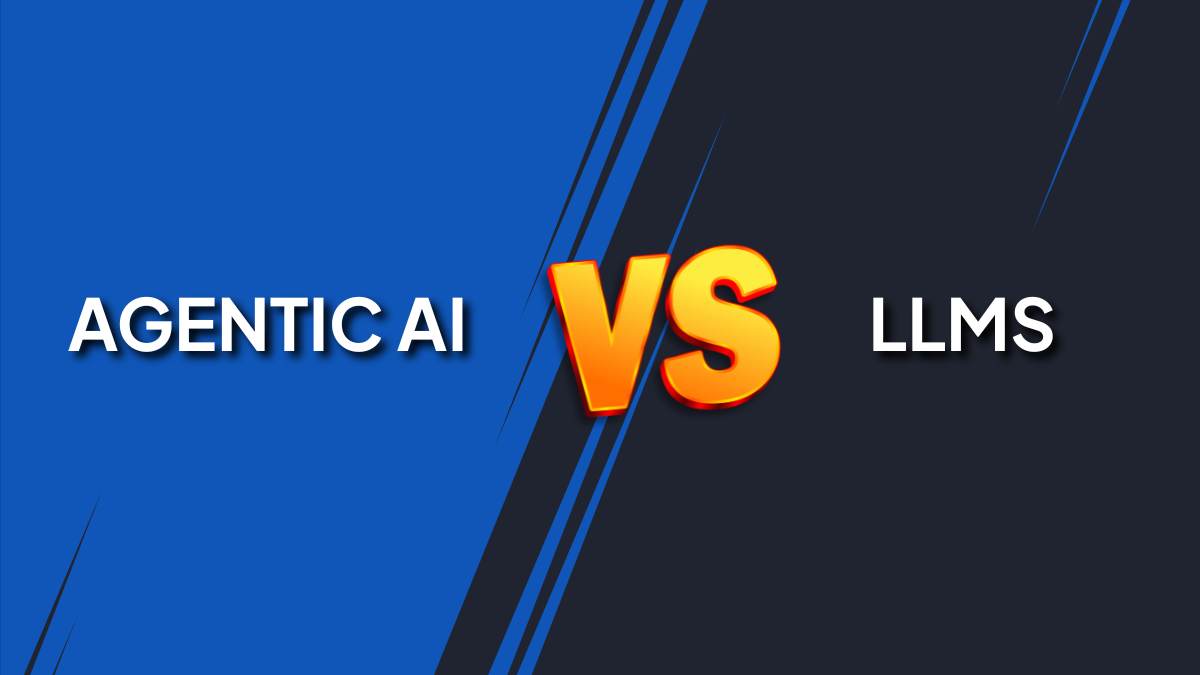Agentic AI vs LLMs: Overview
Agentic AI vs LLMs isn’t just a buzzword clash; it’s shaping how businesses and researchers think about the future of technology. The way AI has evolved is honestly wild. We’ve gone from machines that could only follow strict rules to systems that now feel almost alive in how they adapt and learn. But here’s the catch: not every AI is built the same. Some are brilliant at generating text or answering questions, while others are designed to act more like problem-solvers that can make decisions with less hand-holding. Knowing the difference really does matter if you’re building products or planning where to invest.
What is Agentic AI?
Agentic AI is basically artificial intelligence that can set goals and work towards them without constant nudging. Instead of waiting for commands, it can decide, act, and adjust on its own. That’s the big shift from traditional systems, it’s less about rigid programming and more about autonomy. Its strengths lie in decision-making, adaptability, and being able to follow through on complex tasks. You’ll see agentic AI applications in areas like robotics, logistics, and even advanced AI assistants. In short, it’s about creating intelligent agents that don’t just react, but actually push things forward.
What are Large Language Models (LLMs)?
Large language models, on the other hand, are all about language. Their job is to understand context and generate human-like text. They’re trained on massive datasets, broken down into tokens, and use a transformer architecture to predict what comes next in a sentence. Popular names here include GPT, PaLM, and LLaMA. LLMs excel at natural language understanding, which is why they power chatbots, content creation tools, and even code generation. If agentic AI is about autonomy, LLMs are about fluency, they can’t act on their own goals, but they can process and produce language at scale in ways that feel very natural.
Table of Contents
Agentic AI vs LLMs: Key Differences
| Area | Agentic AI | Large Language Models (LLMs) |
| What it does | Built to take goals, make choices, and act on its own. | Mainly built to read, understand, and generate text that sounds human. |
| Level of autonomy | Pretty high, it doesn’t need someone constantly telling it what to do. | Low, always needs a prompt or some input before it can respond. |
| Decision-making | Can figure out next steps by itself, based on the situation. | Doesn’t really “decide,” it just produces the most likely text response. |
| Adaptability | Adjusts when the environment changes or new problems show up. | Stays locked within the instructions given; not great at handling shifting goals. |
| Style of interaction | More proactive, almost like an assistant that runs with the task. | Reactive, waits for input, then answers. |
| Where it’s used | Robotics, autonomous vehicles, complex task automation, smart agents. | Content creation, customer chats, coding help, writing support. |
| Strong points | Independence, can manage full tasks end-to-end, handles complexity. | Really good at language, scales easily for text-heavy jobs. |
| Weak points | Harder to build, needs more resources, trickier to control. | Needs clear prompts, can’t set its own goals. |
| Quick example | A delivery robot planning its own route when a street is blocked. | A chatbot replying to a customer question. |
| In short | Think of it as autonomy-first AI. | Think of it as language-first AI. |

Enroll Now: Ai Marketing Course
How Agentic AI Enhances LLMs
- LLMs are great at language, but they wait for prompts. Agentic AI fills that gap by adding independence.
- When you connect the two, you get systems that can not only talk or write but also decide what to do next.
- Example: an autonomous AI agent powered by an LLM could answer a customer query, check inventory, and even trigger an order without being told each step.
- Benefits include:
- Faster problem-solving (no back-and-forth needed all the time).
- More natural, dynamic interactions since the agent “remembers” goals.
- Better contextual understanding because it’s not just reacting, it’s planning.
- Faster problem-solving (no back-and-forth needed all the time).
Use Cases of Agentic AI vs LLMs
Agentic AI use cases:
- Robotics (machines that make decisions on the ground).
- Autonomous vehicles that adapt to real-world conditions.
- AI assistants that can manage tasks end-to-end.
LLM use cases:
- Content generation (blogs, copy, product descriptions).
- Chatbots for customer service.
- Code generation and developer support.
- Answering knowledge-based questions.
When to choose what:
- If you need autonomy and decision-making (like logistics, robotics, or vehicles), go with agentic AI.
- If your work is more about language, communication, or scaling content, LLMs are the right fit.
- Honestly though, many real projects benefit from a mix, the autonomy of agentic AI with the language skills of LLMs.
Also read: Rational Agents in AI: Working, Types and Examples
Advantages of Agentic AI
Self-directed tasks
The biggest win with agentic AI is that it doesn’t need babysitting. Once you set the goal, it can carry things forward on its own. This makes it really useful when you can’t afford to micromanage or constantly feed instructions for every little step.
Decision-making autonomy
Agentic AI can actually weigh options and decide on a path instead of just reacting. That means it can deal with situations where the “next step” isn’t obvious. For businesses, that saves time and helps cut down on human intervention in repetitive or even complex tasks.
Adaptability in dynamic environments
Traditional systems often freeze when conditions change, but agentic AI is more flexible. If something unexpected happens, like a sudden supply chain issue, it can recalculate and keep working. This adaptability makes it better suited for real-world environments that are messy and unpredictable by nature.
Also Read: Agentic AI vs AI Agents
Limitations of Agentic AI
Complexity
Building agentic AI isn’t simple. It needs advanced design, testing, and continuous monitoring. Small mistakes in setup can create huge issues later. That complexity also means longer timelines and higher costs, which is why only well-prepared organizations tend to use it successfully right now.
Higher resource requirements
Because it’s running constantly and making decisions on the fly, agentic AI usually eats up more resources. You’re looking at higher computing power, more data processing, and bigger budgets. For smaller companies, those requirements can be a serious roadblock to even getting started.
Advantages of LLMs
Language understanding
LLMs are fantastic at working with natural language. They can take a messy question, figure out the intent, and respond in a way that feels natural. This makes them useful in everything from customer support to creating content to simplifying technical information for wider audiences.
Scalability for text-based applications
Once an LLM is set up, it can be scaled across hundreds or thousands of applications without a big drop in performance. Whether it’s customer chats, content production, or answering FAQs, the ability to scale fast is one of the main reasons businesses adopt them.
Also Read: AI Agents for Marketers
Limitations of LLMs
Dependence on prompts
LLMs don’t act until someone tells them to. Their output depends heavily on the quality of the prompt, which means vague or poorly worded inputs can lead to weak answers. This dependence limits their reliability in situations where accuracy really matters.
Lack of independent goal-setting
They don’t set objectives on their own. LLMs can generate responses, but they won’t plan out tasks or manage processes independently. That lack of goal-setting is fine for writing or conversation, but it makes them less useful for jobs that require follow-through.
Also Read: What is Multi-Agent AI?
Future Trends in Agentic AI and LLMs
Emerging trends in autonomous AI
Agentic AI is moving into more industries, from logistics to healthcare. The idea is that these systems will run more independently, handling decisions that used to require human approval. Over the next few years, this type of autonomy will likely become a standard part of daily operations.
LLM advancements: multimodal, reasoning improvements
LLMs are shifting from just text into multimodal systems, meaning they can work with images, audio, maybe even video. Alongside that, they’re slowly improving in reasoning, so their answers aren’t just fluent but more accurate and useful. This trend will make them far more versatile.
Potential convergence of agentic AI and LLMs
There’s a lot of excitement around merging the two. If you combine the autonomy of agentic AI with the language skills of LLMs, you get systems that can both act and explain. That convergence could change how businesses and individuals interact with AI completely.
Ethical considerations and responsible AI
As these technologies grow, the risks also grow. Who’s accountable if an autonomous system makes the wrong decision? How do we prevent bias or misuse? Ethical questions like these will become more urgent, and companies will need clear frameworks before deploying advanced AI systems at scale.
Also read: Generative AI vs Predictive AI: Key Differences
Conclusion
Agentic AI and LLMs are not competing technologies as much as they are complementary. Agentic AI brings autonomy and decision-making, while LLMs bring the ability to understand and generate language at scale. Knowing the strengths and limits of each helps you choose the right approach for your business or project.
The future likely lies in their convergence, autonomous agents powered by LLMs that can act, decide, and communicate seamlessly. For marketers, developers, or business leaders, understanding this distinction isn’t just technical knowledge, it’s a strategy advantage.
FAQs: Agentic AI vs LLMs
What is the difference between agentic AI and LLMs?
The core difference is that agentic AI can act on its own, make choices, and keep moving toward a goal. LLMs, on the other hand, are focused on language, they understand and generate text but always need a prompt to get started.
Can LLMs become agentic AI?
On their own, no. LLMs don’t have decision-making built in. But when combined with agentic frameworks, they can be part of autonomous systems. That’s where things get interesting, you can give them not just a voice, but also the ability to take action.
Which is better for automation: agentic AI or LLMs?
It depends on the task. For jobs that need independence, like a delivery robot or managing a supply chain, agentic AI is the better choice. For anything text-heavy, content creation, chat support, code help, LLMs are usually more practical and cost-effective.
Are agentic AI systems more resource-intensive than LLMs?
Yes, usually. They demand more computing power and are harder to build and maintain. LLMs are relatively lighter once trained and can be scaled widely. Agentic AI brings autonomy, but that comes with higher costs and infrastructure needs.
How do businesses use agentic AI vs LLMs today?
Many companies use LLMs for customer service, marketing, and content workflows. Agentic AI is showing up in robotics, logistics, and autonomous tools that need to act without constant input. Increasingly, businesses are experimenting with combining both, using LLMs for communication inside agentic AI systems.

